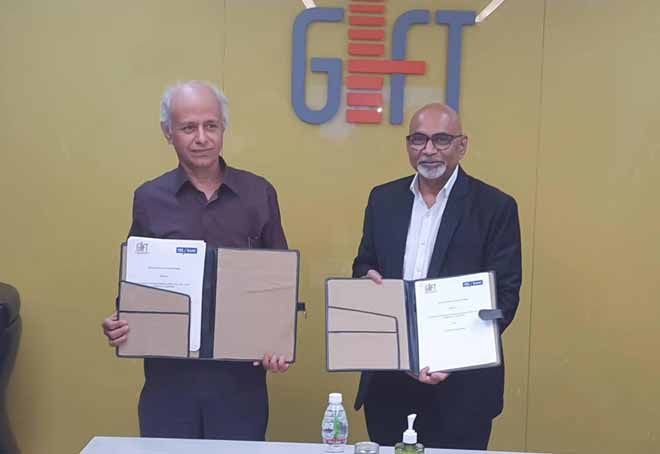Listing of shares by SMEs without an IPO
Updated: Oct 21, 2013 04:27:59pm

As a thumb rule, when the certainty in success in business is low or where risks in the business initiatives are high, the reliance should be placed more on equity capital where the obligation to return income to the investors is dependent on the success of the business and only when profits are generated. Equity acts as a shock absorber under uncertain business scenarios or conditions. If on the other hand, a business places more reliance on debt, with definite servicing obligations in the form of repayment of instalments and payment of interest, irrespective whether the business is returning profits or in losses, puts undue pressure on the profit margins and also on the cash flows. Finding an ideal mix of debt and equity given the business risks is one of the key differentiating factor in successful businesses and not so-successful ones. Easier said than done!
At the initial stage of operations, it is more likely for a business to face difficulties in raising any type of finance, namely, debt or capital. At a later stage, the change in financial leverage is not so easy to achieve given the covenants or terms and conditions that are attached to the debt finance. Further, for equity finance, it is important to match the investor expectation in terms of value creation and capital appreciation. A business venture (or a business idea in the initial stage) thus has to plan an appropriate mix of debt and equity and strive to achieve an equilibrium of sorts – servicing debt obligations on a timely basis and achieving highest possible returns and value creation for the investors.
Mighty oaks from little acorns grow! This is true for all large enterprises, national or cross-border. What made them big – appetite for growth, readiness to accept risks and turn them into opportunities, willingness to employ professional help, reward the professional team for the successes achieved. While it is true that many small ventures are willing to grow bigger and better, not many are successful. The limitations are on account of professional reach or due to limitations on available capital or a combination of both.
SEBI has provided with a platform for SMEs accessing capital by issuing IPOs on the SME Exchange. BSE and NSE have started the SME Exchanges; platforms aimed for accessing capital by SME businesses and also liquidity for investors. Although it has been nearly 3 years since the regulations allowing SME issues on SME Exchanges have been issued, the number of companies listed on the platforms, have been only a handful with actual trades happening on the bourses for such listed scrips, even lower.
The lack of interest in the SME Exchanges has been attributed to – general market conditions, current cost structure for bringing out an issue being very high, some structural issues in the form of Merchant Banker requirement for taking risk (without they having the appetite or the capital base to do so), market making requirements, lack of depth and interest on account of high value in terms of lot size at the time of IPO and for subsequent trades, limited awareness about the actual requirements and ways-and-means for accessing capital markets amongst SMEs, limited faith of investors, legacy of not-so-successful attempts of the past like OTCEI, etc.
While the above mentioned factors have been discussed and attributed for the limited popularity and depth, it has also been felt that institutional investors or issuers may not really be keen in accessing fresh capital from the market, but may like to find value for their existing investments or assess the investor acceptability of the company amongst the investor class, before a subsequent IPO could be thought of.
To allow institutional investors or alternative investment funds (such as venture capital funds or angel investors) finding true market value for their investments in the investee companies, SEBI has now provided an opportunity for listing of shares even without the IPO route. It is too early to hazard a bet on whether this enabling avenue would result in investors and investee companies exploring it, or it would suffer the same lackadaisical response from the SME segment as the SME Exchange. It may be clarified here that SEBI has not defined the SME segment nor has it limited access on the ITP segment or on the SME Exchange to companies, which fall in the definition of MSME under the Micro, Small & Medium Enterprises Development Act, 2006. In fact the ITP and SME Exchange are open to any company so long as the post-issue paid up capital does not exceed Rs. 25 crore.
SEBI issues regulations for listing by SMEs without IPO
SEBI has released the regulations allowing for listing on the SME Exchange by companies without going in for an IPO on an Institutional Trading Platform (ITP) under the umbrella of the SME Exchanges. Although, the same was approved by SEBI around 4 months ago, the regulations have been issued only recently. The regulations have the effect of amending SEBI (ICDR) Regulations, 2009 (through introduction of chapter XC), SEBI (Substantial Acquisition of Shares & Takeovers) Regulations, 2011 and SEBI (Delisting of Equity Shares) Regulations, 2009. The option of listing on ITP is available only to such enterprises as per the criteria and manner as fitted in the broad categories given below.a) Vintage criteria, as on the date of application for listing on an ITP:
b) The Company should have at least one year’s audited financial results. (The period would get extended to a minimum of 3 years existence assuming that no due- diligence criteria mentioned below, other than the Company having credit history with a scheduled bank); and
c) The Company should not have been in existence for more than 10 years;
d) Size criteria:
(i) the company’s revenues should have been less than Rs. 100 crore in any of the previous financial years; and
(ii) the paid up capital of the company shouldn't have exceeded Rs. 25 crore in any of the previous financial years;
e) Governance criteria:
(i) the company, its promoter, group company or director do not appear in the willful defaulters list of Reserve Bank of India as maintained by Credit Information Bureau (India) Limited (it is not clear though, whether the requirement is to be met as on the date of application or the names shouldn't appear in any of the list so published. It would be better if it means for all the quarterly lists disclosed on the CIBIL website. If not, at least a cooling period of 5 years should be maintained from the date of last quarter when the name so appeared);
(ii) there is no winding up petition against the company that has been admitted by and pending before a competent court (as on the date of application);
(iii) the company, group companies or subsidiaries have not been referred to the Board for Industrial and Financial Reconstruction within a period of 5 years prior to the date of application for listing; and
(iv) no regulatory action has been taken against the company, its promoter or director, by the Board, Reserve Bank of India, Insurance Regulatory and Development Authority or Ministry of Corporate Affairs within a period of 5 years prior to the date of application for listing;
f) due diligence assurance criteria:
(i) at least one alternative investment fund, venture capital fund or other category of investors / lenders approved by SEBI has invested at least Rs. 50 lakh in equity shares of the company (it may be noted here that no minimum lock-in period has been specified under this category); or
(ii) at least one angel investor who is a member of an association/group of angel investors who fulfill the criteria laid down by the recognised stock exchange, has invested at least Rs. 50 lakh rupees in the equity shares of the company through such association/group (it may be noted here that no minimum lock-in period has been specified under this category); or
(iii) the company has received finance from a scheduled bank for its project financing or working capital requirements and a period of 3 years has elapsed from the date of such financing and the funds so received have been fully utilized (it may be noted here that no minimum amount of credit has been specified under this category); or
(iv) a registered merchant banker has exercised due diligence and has invested not less than Rs. 50 lakh rupees in equity shares of the company which shall be locked in for a period of 3 years from the date of listing; or
(v) a qualified institutional buyer has invested not less than Rs. 50 lakh in the equity shares of the company which shall be locked in for a period of 3 years from the date of listing; or
(vi) a specialized international multilateral agency or domestic agency or a public financial institution as defined under section 4A of the Companies Act, 1956 has invested in the equity capital of the company (it may be noted here that, no minimum quantum specified nor any minimum lock-in period specified under this category);
g) Other requirements and conditions:
(i) the ITP listing would not involve any public issue of shares. Also, no IPO can be made so long as the shares are listed on the ITP. However, a company can make rights issue (without renunciation rights) or private placements (at higher of book value as per the last audited results, not older than 6 months or value determined by the registered Merchant Banker or by an independent auditor) while the shares are listed on the ITP;
(ii) promoter holding should at least be 20% on the date of listing and be locked in for a period of at least 3 years from the date of listing on ITP;
(iii) disclosures are required to be provided as per Schedule XIXA of SEBI (ICDR) Regulations, 2009, which inter alia includes details about the company, its promoters, principal products produced and services rendered, principal markets; information on raw materials; number of persons employed by the company, litigations pending, financial information, risk factors identified, etc.; and
(iv) shares to be traded on ITP only in dematerialized form with minimum trading lot size of Rs. 10 lakh
Disconnect and gaps in the inter se requirements
SEBI had undertaken consultations with a wide segment of merchant bankers, stock exchange representatives, venture funds, consultants and few associations representing SMEs. It has, through the regulations, tried to keep a balance between the expectations of different segments. However, there does seem to be a disconnect, particularly in the due-diligence criteria, as some conditions are less stiff when compared to other conditions, for instanceo The eligibility condition of investment of minimum Rs. 50 lakhs by alternative investment funds (venture capital funds (VCFs) / private equity fund), also appears to be relatively stiff, even when there is no lock-in criteria for such investment post listing. Of the 35 companies listed on BSE SME platform only one has VCF investment whereas on 3 companies listed on NSE’s Emerge, 2 have VCF investment.
o Similar requirement of at least one angel investor, who meets such criteria as may be laid out by the stock exchanges, investing Rs. 50 lakhs in the SME shares is dependent on the criteria laid out by the stock exchanges.
o Project appraisal and lending or working capital lending by a Scheduled Bank doesn’t specify the quantum. It is required that 3 years should have passed since the finance should have been sanctioned and fully utilized. The requirement can easily be met by most of the SMEs, as it would be possible to access a small security based credit from any scheduled bank (including a scheduled cooperative Bank).
o The requirement of a registered Merchant Banker taking equity position on in the SME listed on the ITP for a minimum amount of Rs. 50 lakhs and for a minimum period of 3 years from the date of listing is perhaps the most dubious eligibility requirement of all. Normally Merchant Bankers being service providers do not require a high capital base. Given that they would have to remain invested for a period of 3 years, they would require sufficient capital base to support the number of issues handled by them. The requirement could remain largely on paper.
Another area that the regulators have decided on is the barrier limit of maximum 10 years of existence and a limit of Rs. 100 crore in terms of turnover. The idea was to exclude the stagnating companies from accessing the ITP. However, this barrier is also likely to exclude companies being run by the 2nd or 3rd generation. Such companies offer a mix of experience of the earlier generation and dynamism and professionalism brought in by the younger generation. There are many such companies who would have liked to access the ITP.
Further the revenue barrier has the effect of excluding high turnover companies in the SMEs having low value addition or where the cost of raw material processed is very high. Arithmetically viewing the limit also doesn’t offer a sound logic to the barrier imposed. Assuming maximum paid-up capital base limit of Rs. 25 crore (i.e. the maximum permissible limit on the ITP and on the SME Exchange), assuming say a net worth of a modest Rs. 40 crore and a conservative debt-to-equity ratio of 1:1, would result in a total capital investment of Rs. 80 crore. The turnover limit of Rs. 100 crore (asset turnover ratio of just 1.25) would be grossly low and most companies in the capital asset base of Rs. 80 cr would breach the barrier of Rs. 100 crore. It appears that the limits imposed didn’t have any data analysis to back the same. Although aimed at keeping the large companies from accessing the ITP, the barrier would also exclude a lot of SMEs from the ITP. The objective of keeping the large companies out of the ITP could have been easily achieved with the ceiling of Rs. 25 crore of post-issue paid up capital i.e. the same maximum limit for listing on the SME Exchange. Need of the hour is for encouraging good companies getting listed on SME Exchange or on the ITP, and such artificial barriers could have been best avoided.
The high trading lot of Rs. 10 lakh proposed is to deter non-serious investors. The same is likely to impact liquidity. Given the fact that minimum trading lot of Rs. 1 lakh stipulated on the SME IPOs listed on the SME Exchange have not generated enough liquidity on the exchanges, SEBI could have considered of keeping the trading lot for ITP too at Rs. 1 lakh. A relatively smaller trading lot of Rs. 1 lakh is also adequate enough to deter non-serious investors or speculative traders from the SME counters.
Suggestions
The requirement of compulsory grading of shares desiring to be listed on the ITP is missing. The same is missing even for the IPOs getting listed on the SME Exchange. Listing of good investee companies having sound corporate governance is a condicio sine qua non for healthy development of any capital market. The need therefore is listing of companies with good governance practices on the SME Exchange or on the ITP, which would generate retail investors’ interest on the SME stocks. Information about the performance of, and governance standards adopted by SMEs is not easily available in the public domain, especially before such companies get listed. Grading of the scrips by rating agencies, albeit on a specific SME scale, would bridge the gap of credible information about the companies getting listed. It may be of interest to readers to note that out of the 35 companies listed on BSE, none of them have been graded. On the other hand, all companies listed on NSE have been graded by rating agencies. In the absence of grading, it’s the exchanges’ added responsibility to act as effective gate-keepers avoiding listing of fly-by-night issuers and spoiling the market.SME Exchange and ITPs should also encourage and take the initiative of providing research reports on the companies listed. The more information about companies listed are provided, the better it would be for the companies listed and also for the investors interested in the SME scrips. Needless to add a healthy market is a win-win for all constituents. The vision has to be long term if the exchanges are keen on having a sustainable model for SME listings.
End note
SEBI has issued the regulations giving an additional opportunity for SMEs in exploring the capital market. Institutional investors namely, venture funds, angel funds, or any other alternative investment funds now get an opportunity to find a value for their investments without going through the IPO route. After all, IPO route for price discovery may not be feasible on account of costs involved and thus not entirely desirable. ITP does provide a tangible price discovery platform before the plunge of IPO is undertaken by the existing investors wanting to exit or by the investee companies in accessing the capital market. The author acknowledges that it is humanly impossible for SEBI to keep all quarters satisfied and hence the regulations can definitely be considered as a work-in-process and is in the right direction. In the meantime, it is also a recognised fact that investors would have to undertake necessary due-diligence and read the prospectus minutely and analyze the financial results more carefully before investing in the shares of SMEs. They also have to accept that the bucks would be made, in the long run. SME Exchange or ITP is not a place for quick bucks or for speculative gains! (KNN)*The writer is former SME Head, ICRA











